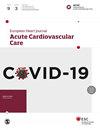Comparison of the clinical chemistry score to other biomarker algorithms for rapid rule-out of acute myocardial infarction and risk stratification
IF 3.9
2区 医学
Q1 CARDIAC & CARDIOVASCULAR SYSTEMS
European Heart Journal: Acute Cardiovascular Care
Pub Date : 2024-05-09
DOI:10.1093/ehjacc/zuae036.058
引用次数: 0
Abstract
Funding Acknowledgements None. Background The clinical chemistry score (CCS) comprising high-sensitivity (hs) cardiac troponins (cTn), glucose and estimated glomerular filtration rate has been previously validated with superior accuracy for detection and risk stratification of acute myocardial infarction (AMI) compared to hs-cTn alone. Methods The CCS was directly compared to other biomarker-based algorithms for rapid rule-out and prognostication of AMI including the hs-cTnT limit-of-blank (LOB, <3 ng/L) or limit-of-detection (LOD, <5 ng/L) and the dual marker strategy (DMS) (copeptin <10 pmol/L and hs-cTnT ≤14 ng/L) in 1506 patients presenting to the emergency department (ED) with symptoms suggestive of acute coronary syndrome. Negative predictive values (NPV) and sensitivities for rule-out of AMI were assessed and outcomes included rates of the combined end-point of all-cause mortality, myocardial re-infarction and stroke within 12 months. Results NPVs of 100% (98.3-100%) could be found for a CCS=0, hs-cTnT LoB and hs-cTnT LoD with rule-out efficacies of 11.1%, 7.6% and 18.3% as well as specificities of 13.0% (9.9-16.6%), 8.8% (7.3-10.5%) and 21.4% (19.2-23.8%), respectively. A CCS≤ 1 achieved a rule-out in 32.2% of all patients with a NPV of 99.6% (98.4-99.9%) and specificity of 37.4% (34.2-40.5%) compared to a rule-out efficacy of 51.2%, NPV of 99.0 (98.0-99.5) and specificity of 59.7% (57.0-62.4%) for the DMS. Rates of the combined end-point of death/AMI within 30 days ranged between 0.0% and 0.5% for all fast-rule-out protocols. Conclusions The CCS enables a reliable rule-out of AMI with low outcome rates in short and long-term follow-up for a specific population of ED patients. However, compared to a single or dual biomarker strategy, the CCS rule-out is attenuated by a loss of specificity and lower efficacy. Thus, the clinical benefit of the CCS in clinical practice seems to be negligible.临床化学评分与其他生物标记算法在快速排除急性心肌梗死和风险分层方面的比较
无。背景 由高灵敏度(hs)心肌肌钙蛋白(cTn)、葡萄糖和估计肾小球滤过率组成的临床化学评分(CCS)已经过验证,与单独使用 hs-cTn 相比,CCS 在急性心肌梗死(AMI)的检测和风险分层方面具有更高的准确性。方法 将 CCS 与其他基于生物标记物的快速排除 AMI 和预后算法(包括 hs-cTnT 空白极限(LOB,<3 ng/L)或检测极限(LOD,&;lt;5纳克/升)和双标志物策略(DMS)( copeptin <10 pmol/L 和 hs-cTnT ≤14 纳克/升)。评估了排除急性冠状动脉综合征的阴性预测值(NPV)和灵敏度,结果包括12个月内全因死亡率、心肌梗死和中风的综合终点发生率。结果 CCS=0、hs-cTnT LoB 和 hs-cTnT LoD 的净现值均为 100%(98.3-100%),排除率分别为 11.1%、7.6% 和 18.3%,特异性分别为 13.0%(9.9-16.6%)、8.8%(7.3-10.5%)和 21.4%(19.2-23.8%)。CCS≤1可排除32.2%的患者,NPV为99.6%(98.4-99.9%),特异性为37.4%(34.2-40.5%),而DMS的排除率为51.2%,NPV为99.0(98.0-99.5),特异性为59.7%(57.0-62.4%)。在所有快速排除方案中,30 天内死亡/AMI 合并终点的发生率介于 0.0% 和 0.5% 之间。结论 CCS 可以可靠地排除急性心肌梗死,但对特定的急诊室患者群体而言,短期和长期随访的结果率较低。然而,与单一或双重生物标记物策略相比,CCS 的排除作用因特异性降低和有效性降低而减弱。因此,在临床实践中,CCS 的临床益处似乎微乎其微。
本文章由计算机程序翻译,如有差异,请以英文原文为准。
求助全文
约1分钟内获得全文
求助全文
来源期刊

European Heart Journal: Acute Cardiovascular Care
Medicine-General Medicine
CiteScore
8.50
自引率
4.90%
发文量
325
期刊介绍:
The European Heart Journal - Acute Cardiovascular Care (EHJ-ACVC) offers a unique integrative approach by combining the expertise of the different sub specialties of cardiology, emergency and intensive care medicine in the management of patients with acute cardiovascular syndromes.
Reading through the journal, cardiologists and all other healthcare professionals can access continuous updates that may help them to improve the quality of care and the outcome for patients with acute cardiovascular diseases.
 求助内容:
求助内容: 应助结果提醒方式:
应助结果提醒方式:


